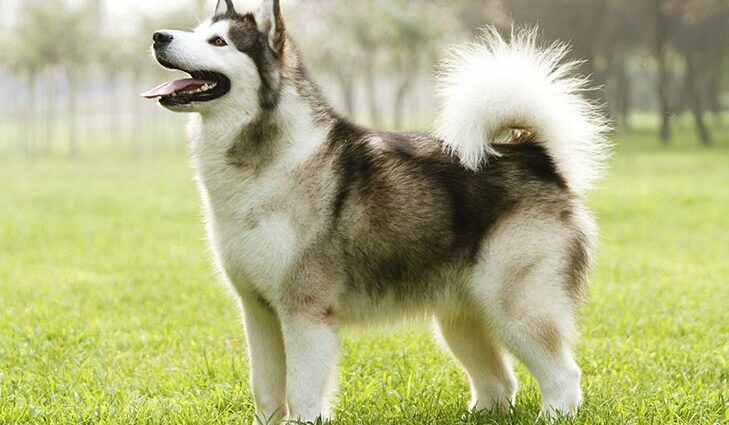Contents
Alaskan malamute
Physical Characteristics
There is a large variation in size and weight in the Alaskan Malamute and it is therefore the pace and proportions that are preferred to determine the standard. The chest is well let down and the strong body is well muscled. Its tail is carried on the back and in plume. He has a thick, coarse outer coat with a dense, thick undercoat. Usually her dress varies from light gray to black, but many variations are allowed.
The Alaskan Malamute is classified by the Fédération Cynologiques Internationale among the Nordic sled Spitz type dogs. (1)
Origins and history
The Alaskan Malamute is believed to be a direct descendant of the domesticated wolves that accompanied Paleolithic hunters as they crossed the Bering Strait about 4000 years ago, and then, later, through their migration to the North American continent. Alaskan Malamute breeder Paul Voelker believes this is probably the oldest breed of dog on the American continent.
The name of Alaskan Malamute refers to the Malamute dialect, spoken by an Inuit people of Alaska, the Iñupiat.
The dogs of this region were originally used for hunting and especially polar bear hunting. According to archaeological research, it is only very recently, between three and five hundred years ago that the use of dog sledding became widespread. Even more recently, during the Gold Rush of the late 1800s, prospectors saw the benefits of owning dog sleds and the Alaskan Malamute has emerged as a go-to choice.
Eventually, after almost disappearing, the breed was officially recognized in 1935 and the same year the Alaskan Malamute Club of America was established. (2)
Character and behavior
He is very intelligent and a quick learner, but can have a strong character. It is therefore recommended to start training very early. The Alaskan Malamute is a pack dog and this is reflected in his character. A pack has only one dominant and if the animal sees itself as such, it can become uncontrollable by its master. He is, however, a faithful and devoted companion. He is also an affectionate and friendly dog with strangers. The breed standard also describes him as « impressive dignity in adulthood ”. (1)
Common pathologies and illnesses of the Alaskan Malamute
The Alaskan Malamute has a life expectancy of around 12 to 14 years. He is a hardy dog and, according to the UK Kennel Club’s 2014 Purebred Dog Health Survey, nearly three-quarters of the animals studied showed no signs of disease. Among the remaining quarter, the most common condition was lipoma, a benign tumor of fatty tissue. (3)
Like other purebred dogs, however, he is susceptible to developing hereditary diseases. These include in particular hip dysplasia, achondroplasia, alopecia X and polyneuropathy. (4-5)
Coxofemoral dysplasia
Coxofemoral dysplasia is an inherited defect of the hip joint that results in painful wear and tear, tears, inflammation, and osteoarthritis.
Diagnosis and assessment of the stage of dysplasia is mainly done by x-ray.
The progressive development with age of the disease complicates its detection and management. The first-line treatment is often anti-inflammatory drugs or corticosteroids to help with osteoarthritis. Surgical interventions, or even the fitting of a hip prosthesis can be considered. A good medication management can be enough to improve the comfort of life of the dog. (4-5)
L’achondroplasie
Achondroplasia, also called short-limb dwarfism, is a condition that affects the formation of long bones. It has the effect of shortening and curvature of the limbs.
The disease is visible from a young age. Affected dogs grow slower than their peers and their legs are shorter than average, while the head and body are of normal size. The limbs are more or less curved and weak.
The diagnosis is mainly based on a physical examination and x-ray. The latter reveals thicker and shorter long bones. (4-5)
There is no cure and the prognosis is usually very poor for dogs like the Alaskan Malamute since the disease can prevent them from walking.
Alopecia X
Alopecia X is the most common disease in Nordic and Spitz-type dogs. It is a skin condition whose causes are unknown. It is characterized first of all by an altered appearance of the coat (dry, dull and brittle hair) then, gradually, the dog loses all its hair on the affected areas.
The first signs usually appear in areas of friction, such as the neck or the base of the tail. Ultimately, the disease can affect the whole body and the skin in the affected areas becomes dry, rough and hyperpigmented.
Breed predisposition is an important diagnostic criterion, but a skin sample from an affected area and histological examination are necessary to rule out other alopecia. This disease mainly affects adult dogs, without prevalence of sex and the general condition of the animal remains good.
There is currently no consensus regarding the treatment. In males, castration results in hair regrowth in about 50% of cases, but relapse is still possible. The majority of treatments currently target hormone production. (4-5)
Polyneuropathy
Polyneuropathy is a neurological condition caused by the degeneration of nerve cells in the nerves connecting the spinal cord to the whole body. The first symptoms appear after 1 or 2 years. The dog is intolerant of exertion, presents a slight paralysis of the lower limbs and an abnormal gait. Cough and dyspnea are also possible.
A genetic test can detect this disease
There is no treatment, but in the few cases spontaneous improvement can be observed. (4-6)
See the pathologies common to all dog breeds. |
Living conditions and advice
- The Alaskan Malamute is a very athletic breed, so daily exercise is a must.
- Its coat requires regular brushing and occasionally a bath.










